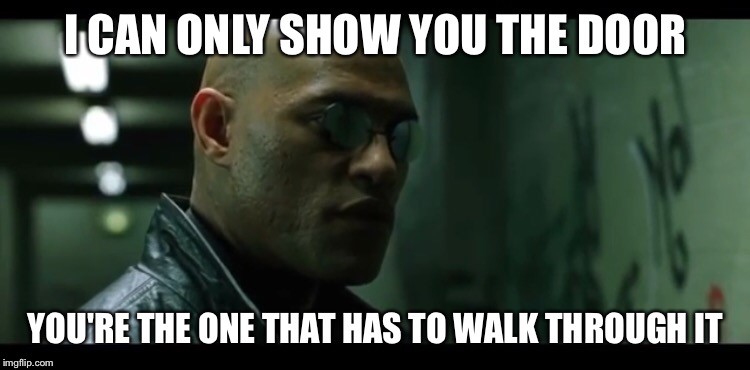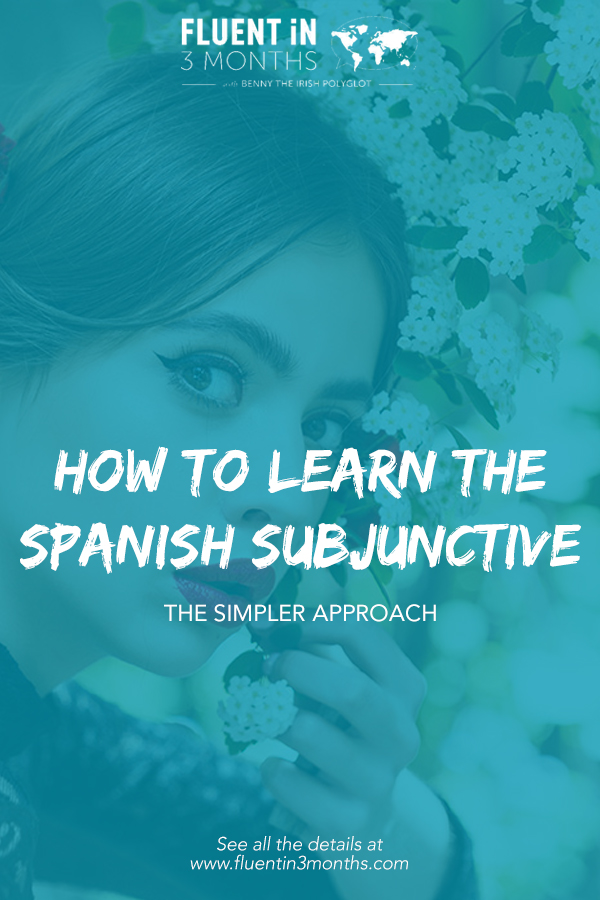How to Learn the Spanish Subjunctive: A Simpler Approach
When you first encounter the Spanish subjunctive, it can feel like its only purpose is to make Spanish harder.
What's the difference between comemos and comamos? Don't they both mean “we eat”? Why does Spanish have two words where English has only one?
It's not just learners of Spanish who struggle here. The subjunctive – sometimes called the “conjunctive” – is found in many European languages – French, Portuguese, Italian, German, and even Welsh, to name just a few. English speakers often struggle to learn it.
The subjunctive is a mood, not a tense. It contrasts with the indicative mood, which is just a fancy word for the “normal” verb forms that are used much more often.
Believe it or not, the Spanish subjunctive doesn't have to be intimidating or difficult.
Most Spanish grammar books explain how to use the subjunctive, but do a bad job of explaining what it actually is. My aim in this article is to give you what the grammar books don't. I want to give you some “a-has” that make you see the subjunctive in a new light, and hopefully make it easier to learn.
My focus will be on the Spanish subjunctive, but the principles I explain should help with the subjunctive in any language.
This article is not:
- A guide to subjunctive verb forms – i.e. the subjunctive endings for hablar, comer, partir etc.. If that's what you're after, I recommended this resource.
- A detailed explanation of the subjunctive's every last subtlety and intricacy. Such explanations are helpful, but starting with them would be like building a house from the roof downwards. My aim here is to give you a foundation.
But first, let's look at the wrong way to learn the subjunctive, otherwise known as “how most people do it”.
How Not to Learn The Subjunctive Mood
My first brush with the subjunctive was in French, not Spanish. My lessons could be a case study in what not to do:
1. Make the Subjunctive Feel Mysterious and Intimidating
I studied French for about ten years in school. The subjunctive was introduced about halfway through. Yep, that's right: it took five years to get there.
Never mind that French/Spanish/etc. children all use the subjunctive with ease. To them, it's just another part of the language – nothing particularly interesting or special about it.
To me, however, the subjunctive was an enigmatic mystery. I'd heard of it, but no-one would explain what it was. People spoke of it in awestruck whispers, like a superweapon too dangerous to handle. Clearly it was far beyond the capabilities of feeble young minds like my own.
So when we did start learning the subjunctive, it felt like a HUGE deal. I'd been conditioned to expect a scary, intimidating, impossibly difficult challenge.
This is not a mindset that's conducive to learning!
2. Treat the Subjunctive as a List of Rules To Be Memorised.
Okay, so you're not falling for the scare tactics. You've built up to the courage to tackle the subjunctive. How will it be presented to you?
Probably something like this: a long and boring list of rules. Use a subjunctive in a subordinate clause with a change of subject when the first verb is blah, blah blah… Asleep yet?
You might learn a mnemonic like “WEIRDO” to help you remember all these rules. But the focus is always on when to use a subjunctive, with too little attention paid to “why”.
As well as being exceptionally boring, this is just about the most slow and ineffective way you can possibly learn the subjunctive. Native speakers don't do it like this! There's a much better way.
The Right Way to Learn the Subjunctive
An analogy: what's the difference between “do” and “make” in English? You might find it obvious, but not everyone agrees.
In Spanish there's just one word – hacer – that means both “do” and “make”. Spanish speakers who learn English are often unsure which word to use.
But to a native English speaker, it barely requires thoughts. “Do” and “make” are different words! They mean different things – isn't it obvious?
You might not always be able to explain the difference (why do we “do the dishes” but “make the bed”?) but still you know what's correct. “Do” and “make” simply feel different.
This is how the subjunctive feels to native Spanish speakers.
If they need to choose between habla (indicative) and hable (subjunctive), they don't think about what the “rules” are. They simply pick the word that means what they want to say. The “WEIRDO” mnemonic doesn't factor into their reasoning.
So, if you want to use the subjunctive correctly, this is the first and most important step you must take: you must understand what it means.
Here's where I hope I can be helpful.
What Does The Subjunctive Mean?
Let's stick with the word hablar – “to speak”. Ella habla español means “she speaks Spanish”, while ella hable español means… “she speaks Spanish”, but it's subjunctive.
When should you use each one? What's the difference in meaning?
The easiest way to see the difference is to compare some example sentences:
Indicative:
- Estoy seguro de que ella habla español (I'm sure she speaks Spanish)
- Es cierto que ella habla español. (It's true she speaks Spanish)
- Sé que ella habla español (I know she speaks Spanish.)
Subjunctive:
- Espero que ella hable español (I hope she speaks Spanish)
- Dudo que ella hable español. (I doubt she speaks Spanish)
- Es posible que ella hable español. (It's possible she speaks Spanish)
- No hay ninguna posibilidad de que ella hable español. (There's no chance she speaks Spanish.)
Go down the list, and for each sentence ask yourself: “does she speak Spanish?”.
As should be clear, in the indicative sentences, the answer is “yes” or “probably”. In the subjunctive sentences, the answer is “maybe” or “no”.
This is the fundamental difference between the indicative and the subjunctive.
Indicative verbs describe reality: actions, certainty, truth, the concrete.
Subjunctive verbs describe possibility: desires, doubts, wants, the ephemeral.
Now, by itself this doesn't teach you everything you need to know. Some situations don't neatly fit into either category. But grasping this “real” vs. “possible”” distinction is the key to a deep understanding of the subjunctive.
Where English Comes in Handy
At this point it's helpful to take a closer look at the English subjunctive.
Wait, what? You heard me right: English has a subjunctive. We just don't usually notice it, because it's a master of disguise.
Take a look at this sentence:
“If I had the money, I would pay you.”
Think about that “had”. At first glance, it appears to be the past tense of “to have”. But why use the past tense? The speaker isn't talking about the past. They're saying that they don't have money now. This sentence is describing a state of affairs in the present.
It seems there's more to that “had” than meets the eye. Ladies and gentlemen, we're dealing with a subjunctive.
Compare it with the simple sentence “I had money”. In this case, had is clearly referring to the past, and is a simple indicative verb. It's the addition of an “if” that shakes things up.
That's the problem: the subjunctive form of “to have” looks just the past tense. In both cases the word is “had”, but the meaning is subtly different.
(Note: I often hear Americans using the the conditional perfect “if I would have” instead of the past subjunctive “if I had”. For example, an American might say “If you would have told me that, I would have said something.”
(I'm not going to get into an argument about prescriptive vs. descriptive grammar. I just want to note that, as a Brit, this really grates my ears. Dear America: please stop saying this. And drop “a long ways” and “on accident” while you're at it.)
The only time the English subjunctive becomes obvious is with the verb “to be”. You can see this in the expression “if I were you”. “I were” is subjunctive, and without an “if” it sounds ungrammatical.
Spanish, on the other hand, makes the distinction clear for all verbs:
- Tenía dinero = I had money. (Tenía is indicative.)
- Si tuviera dinero = If I had money. (Tuviera is subjunctive. It could also be tuviese, which means the same thing.)
As an exercise, compare these English sentences:
- If I had the money, I would pay you.
- If I had had the money, I would have paid you.
- If I have the money, I will pay you.
For each sentence, ask yourself: is the speaker talking about the past, present, or future?
How would the meaning of “had”, “had had” and “have” change if you dropped the “if” in front of it?
Also notice how the verb in the second clause changes based on the first clause – “would pay” vs. “would have paid”, etc.. Can you swap this around and still have it make sense?
Now look at the Spanish translations. Can you see how they follow the same grammatical patterns as their English counterparts?
- Si tuviera el dinero, te pagaría.
- Si hubiera tenido el dinero, te habría pagado.
- Si tengo el dinero, te pagaré.
Thinking about these examples should help you understand what the subjunctive means in both English and Spanish.
More Examples to Help You Understand What The Subjunctive Means
Don't be afraid of your grammar book. I didn't say “never study the rules”, I simply recommended that you don't study them first.
That “WEIRDO” acronym isn't completely useless.
But before you get there, let's look at some more real-world uses of the subjunctive. The below examples all helped me to understand what the subjunctive means.
- Creo que Benny habla chino – I think Benny speaks Chinese. (indicative)
- No creo que Benny hable chino – I don't think Benny speaks Chinese. (subjunctive)
In the first sentence, the implication is that Benny does speak Spanish – as far as the speaker knows. So we use an indicative.
The second sentence introduces an element of doubt. Habla doesn't make sense anymore – we need to switch to the subjunctive hable.
- Es que yo quiero bailar – “It's that I want to dance.” (indicative)
- No es que yo quiera bailar – “It's not that I want to dance.” (subjunctive)
“Es que…” is a common Spanish filler phrase. There's no reason why the first sentence can't be indicative – the speaker wants to dance! We're talking about a real, concrete want.
In the second sentence, things are negated. Now the verb “want” is referring to an abstract non-event, so it must use a subjunctive – quiera.
- Busco a alguien que tiene una barba – indicative
- Busco a alguien que tenga una barba – subjunctive
This is an advanced one! Both sentences mean “I'm looking for someone who has a beard”- but there's a subtle difference.
The first sentence, with the indicative “tiene”, implies that you're looking for a specific bearded person. Say your friend Gandalf has gone missing, and you're trying to figure out whether anyone has seen him. In this case you'd use “tiene”, because your friend is real, and he really has a beard.
The second sentence, however, implies that you're looking for anyone with a beard – you don't care whom. So who's the subject of the verb “have”? No-one in particular – the action of “having a beard” is a theoretical, abstract possibility, not tied to anything concrete in the real world. So you need the subjunctive “tenga”.
This is a great example of how the subjunctive allows for finer shades of meaning that would require extra words to translate precisely into English.
- Ella me dijo que ve Juego de Tronos – “she told me that she watches Game of Thrones“
- Ella me dijo que vea Juego de Tronos – “she told me to watch Game of Thrones.”
This is an example of how the subjunctive is used to describe orders, requests and demands.
The “watches” in the first sentence is a bog-standard indicative. She really does watch Game of Thrones.
The second “watch” is less concrete. I'm not watching Game of Thrones yet (sadly for me). The verb refers to the abstract possibility of me watching it, therefore a subjunctive is in order.
Where To Go From Here?

The subjunctive is a big topic. There are many subtleties that I haven't covered, but I hope I've given you a solid foundation.
It's finally time to dig out your grammar book. Look at the WEIRDO example sentences, contrast with the indicative, and see if it makes sense. I recommend making flashcards to learn the sentence structure.
Just remember the golden rule: focus on the meaning, not rules.
You'll know you've mastered the subjunctive when you no longer realise that you're using it. You won't have to think about it – tenga, hable, sea etc. will come out of your mouth and it won't feel like a big deal. You won't just understand the difference, you'll feel the difference – just like a native speaker would.




Social